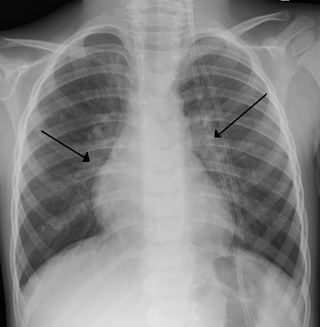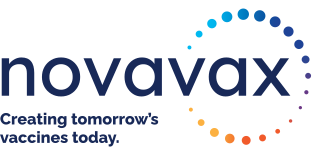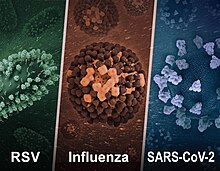
Pneumonia is an inflammatory condition of the lung primarily affecting the small air sacs known as alveoli. Symptoms typically include some combination of productive or dry cough, chest pain, fever, and difficulty breathing. The severity of the condition is variable.

Bronchiolitis is inflammation of the small airways in the lungs. Acute bronchiolitis is due to a viral infection usually affecting children younger than two years of age. Symptoms may include fever, cough, runny nose, wheezing, and breathing problems. More severe cases may be associated with nasal flaring, grunting, or the skin between the ribs pulling in with breathing. If the child has not been able to feed properly, signs of dehydration may be present.

Respiratory syncytial virus (RSV), also called human respiratory syncytial virus (hRSV) and human orthopneumovirus, is a common, contagious virus that causes infections of the respiratory tract. It is a negative-sense, single-stranded RNA virus. Its name is derived from the large cells known as syncytia that form when infected cells fuse.
Community-acquired pneumonia (CAP) refers to pneumonia contracted by a person outside of the healthcare system. In contrast, hospital-acquired pneumonia (HAP) is seen in patients who have recently visited a hospital or who live in long-term care facilities. CAP is common, affecting people of all ages, and its symptoms occur as a result of oxygen-absorbing areas of the lung (alveoli) filling with fluid. This inhibits lung function, causing dyspnea, fever, chest pains and cough.

Influenza-like illness (ILI), also known as flu-like syndrome or flu-like symptoms, is a medical diagnosis of possible influenza or other illness causing a set of common symptoms. These include fever, shivering, chills, malaise, dry cough, loss of appetite, body aches, and nausea, sneezing typically in connection with a sudden onset of illness. In most cases, the symptoms are caused by cytokines released by immune system activation, and are thus relatively non-specific.

The 2009 swine flu pandemic, caused by the H1N1/swine flu/ influenza virus and declared by the World Health Organization (WHO) from June 2009 to August 2010, is the third recent flu pandemic involving the H1N1 virus. The first two cases were discovered independently in the United States in April 2009. The virus appeared to be a new strain of H1N1 that resulted from a previous triple reassortment of bird, swine, and human flu viruses which further combined with a Eurasian pig flu virus, leading to the term "swine flu".
The 2009 flu pandemic in the United States was caused by a novel strain of the Influenza A/H1N1 virus, commonly referred to as "swine flu," that was first detected on 15 April 2009. While the 2009 H1N1 virus strain was commonly referred to as "swine flu," there is no evidence that it is endemic to pigs or of transmission from pigs to people; instead, the virus spreads from person to person. On April 25, the World Health Organization declared a public health emergency, followed concurringly by the Obama administration on April 26.

The 2009 swine flu pandemic in Canada was part of an epidemic in 2009 of a new strain of influenza A virus subtype H1N1 causing what has been commonly called swine flu. In Canada, roughly 10% of the populace has been infected with the virus, with 428 confirmed deaths ; non-fatal individual cases are for the most part no longer being recorded. About 40% of Canadians have been immunized against H1N1 since a national vaccination campaign began in October 2009, with Canada among the countries in the world leading in the percentage of the population that has been vaccinated. The widespread effect of H1N1 in Canada raised concerns during the months leading to the XXI Olympic Winter Games, which took place in Vancouver in February 2010.
The 2009 flu pandemic was a global outbreak of a new strain of influenza A virus subtype H1N1, first identified in April 2009, termed Pandemic H1N1/09 virus by the World Health Organization (WHO) and colloquially called swine flu. The outbreak was first observed in Mexico, and quickly spread globally. On the 11th of June 2009, the WHO declared the outbreak to be a pandemic. The overwhelming majority of patients experience mild symptoms, but some persons are at higher risk of suffering more serious effects; such as those with asthma, diabetes, obesity, heart disease, or those who are pregnant or have a weakened immune system. In the rare severe cases, around 3–5 days after symptoms manifest, the sufferer's condition declines quickly, often to the point respiratory failure. Although Ukraine was not (very) affected at first there was on outbreak of the virus in Western Ukraine in early November 2009 that led to the closing of public buildings and cancellation of meetings for three weeks.


The 2017–2018 United States flu season lasted from late 2017 through early 2018. The predominant strain of influenza was H3N2. During the spring months of March–May, influenza B virus became dominant.

The COVID-19 pandemic, also known as the coronavirus pandemic, is a global pandemic of coronavirus disease 2019 (COVID-19) caused by severe acute respiratory syndrome coronavirus 2 (SARS-CoV-2). The novel virus was first identified in an outbreak in the Chinese city of Wuhan in December 2019. Attempts to contain it there failed, allowing the virus to spread to other areas of Asia and later worldwide. The World Health Organization (WHO) declared the outbreak a public health emergency of international concern (PHEIC) on 30 January 2020, and began referring to it as a pandemic on 11 March 2020. The WHO ended its PHEIC declaration on 5 May 2023, but as of 2 June 2023 continues to refer to it as a pandemic. Prior to this, some countries had already begun to regard COVID-19 as an endemic disease. As of 18 July 2023, the pandemic had caused 767,972,197 cases and 6,950,642 confirmed deaths, ranking it fifth in the deadliest epidemics and pandemics in history.
Allison Joan McGeer is a Canadian infectious disease specialist in the Sinai Health System, and a professor in the Department of Laboratory Medicine and Pathobiology at the University of Toronto. She also appointed at the Dalla Lana School of Public Health and a Senior Clinician Scientist at the Lunenfeld-Tanenbaum Research Institute, and is a partner of the National Collaborating Centre for Infectious Diseases. McGeer has led investigations into the severe acute respiratory syndrome outbreak in Toronto and worked alongside Donald Low. During the COVID-19 pandemic, McGeer has studied how SARS-CoV-2 survives in the air and has served on several provincial committees advising aspects of the Government of Ontario's pandemic response.

The COVID-19 pandemic has had many impacts on global health beyond those caused by the COVID-19 disease itself. It has led to a reduction in hospital visits for other reasons. There have been 38 per cent fewer hospital visits for heart attack symptoms in the United States and 40 per cent fewer in Spain. The head of cardiology at the University of Arizona said, "My worry is some of these people are dying at home because they're too scared to go to the hospital." There is also concern that people with strokes and appendicitis are not seeking timely treatment. Shortages of medical supplies have impacted people with various conditions.
Viral interference, also known as superinfection resistance, is the inhibition of viral reproduction caused by previous exposure of cells to another virus. The exact mechanism for viral interference is unknown. Factors that have been implicated are the generation of interferons by infected cells, and the occupation or down-modulation of cellular receptors.

An alternate care site (ACS) is a medical treatment facility established in a non-traditional setting during a public-health crisis as a means of providing additional capacity to deliver medical care within a given area. The term encompasses both civilian-operated medical facilities established in non-traditional places such as hotels, gymnasiums, and convention centers, or other "structure[s] of opportunity," as well as military field medical units being used for public-health purposes. Usually, the option of establishing an ACS becomes relevant once the scale of an emergency extends beyond a single metropolitan area. Though commonly established by public-health authorities, ACSes can also be established by private entities, such as large employers. ACSes have been widely used as part of the response to the COVID-19 pandemic, and in other recent crises such as the Western African Ebola virus epidemic.
Twindemic and tripledemic are terms used during the COVID-19 pandemic, referring to the possibility of a severe flu season happening alongside an increase in cases of COVID-19 during the fall and winter of 2020 and 2021, as well as respiratory syncytial virus in the winter of 2022. A consequence of a twindemic may be a mixture of two different infections in the same person at the same time. The term twindemic is a portmanteau of "twin" and "pandemic".
The impact of the COVID-19 pandemic on hospitals became severe for some hospital systems of the United States in the spring of 2020, a few months after the COVID-19 pandemic began. Some had started to run out of beds, along with having shortages of nurses and doctors. By November 2020, with 13 million cases so far, hospitals throughout the country had been overwhelmed with record numbers of COVID-19 patients. Nursing students had to fill in on an emergency basis, and field hospitals were set up to handle the overflow.
Anna Banerji M.D., O. Ont. is an academic, a Toronto infectious disease doctor, tropical disease specialist, pediatrician, public health specialist and an activist. She is the founder and chair of both the North American Refugee Health Conference in Canada, the Indigenous Health Conference and the co-founder of the Society of Refugee Healthcare Providers. She was awarded the Dr Peter Bryce Henderson for her advocacy for Indigenous children.
There has been a nursing shortage in Canada for decades. This became more acute in the period between 1943 and 1952 as Canada's health services were expanding, and the number of hospital beds increased along with the number of hospitalizations. By the mid-1940s across Canada the shortage, estimated at 8,700, led to a re-organization and re-conceptualization of nursing in Canada, according to a 2020 journal article in BC Studies. The nature of nursing was changing with new and time-consuming responsibilities, such as the administration of penicillin. During that period, there was no unemployment for nurses, especially if they were willing to be mobile. However, working conditions for nurses were very poor, with low wages combined with long hours; nursing force retention was challenging. As well, since almost all nurses were women, they had responsibilities at home they had to manage. In response to the shortage of nurses, women who had trained as registered nurses (RNs) but had left the workforce when they married, were encouraged to return to work; volunteers were engaged; nursing courses were accelerated; and new categories of regulated nursing were added to registered nursing—"practical nurses" and "nursing assistants." At that time, a "utopia of nursing" referred to teams of nursing staff which included registered nurses and other regulated nursing and hospital worker support personnel. Some of these auxiliary positions were also open to First Nations women and other racialized groups.












